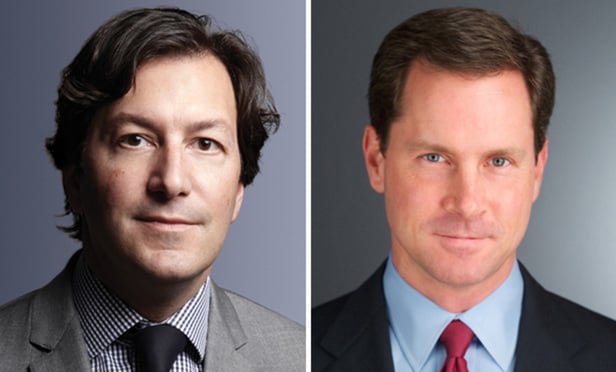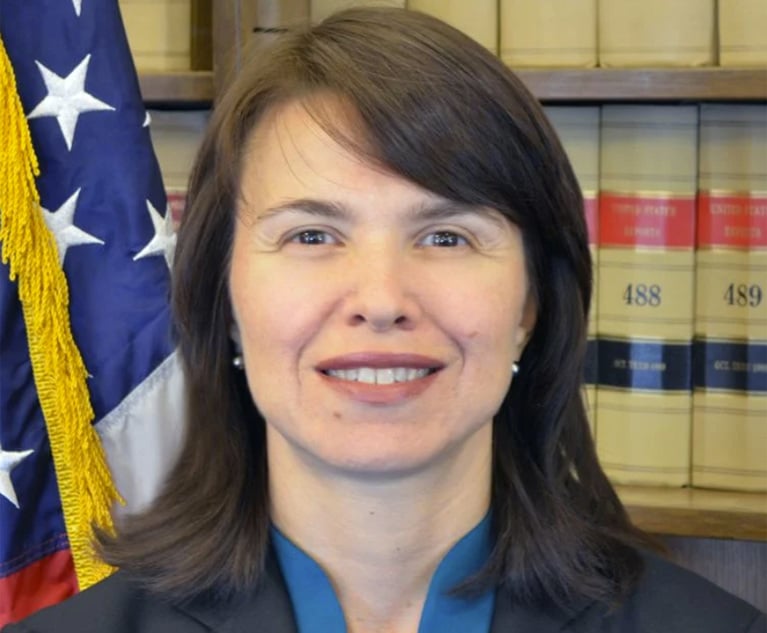Court Infers Intentional, Bad Faith Spoliation From Use of Ephemeral Messaging
In their Federal E-Discovery column, Christopher Boehning and Daniel J. Toal discuss the recent case of 'Herzig v. Ark. Found. for Med. Care', which addresses the issue of ephemeral messaging and spoliation. The court there found that the use of the ephemeral messaging app Signal was evidence of bad faith sufficient to warrant sanctions.
December 02, 2019 at 12:00 PM
8 minute read
 H. Christopher Boehning & Daniel J. Toal
H. Christopher Boehning & Daniel J. Toal
Courts, as well as lawyers and in-house counsel, are struggling with how to apply litigation hold and document management policies with the realities of the many and varied modes of communication. One mode of communication increasingly used in both personal and business contexts is ephemeral messaging. Enormously popular apps such as Wickr, Signal, Wire, WeChat and Confide provide users with the ability to communicate in real time and to set messages to be deleted soon after they are read—often in a matter of seconds.
Are these apps more like voice communications, which similarly are delivered, but which (unless recorded), cease to exist after they are received? Or are they more like emails and "traditional" text messages, which are stored on devices and servers until they are deleted? Or something in between? And how should ephemeral messages be considered by courts when those communicating are aware that their communications could be of interest to a party on the other side of a lawsuit, and the opposing party contends that their loss was an act of spoliation?
The recent case of Herzig v. Ark. Found. for Med. Care, 2019 WL 2870106 (W.D. Ark. July 3, 2019), is one of the first of which we are aware that addresses the issue of ephemeral messaging and spoliation. The court there found that the use of the ephemeral messaging app Signal was evidence of bad faith sufficient to warrant sanctions. But the court's analysis unfortunately does not apply Federal Rule of Civil Procedure (FRCP) 37(e), which was adopted to address the issue of how a claim of spoliation should apply to electronically stored information (ESI). Nor does it, in our view, sufficiently grapple with the question whether ephemeral messaging is sufficiently analogous to voice communications that it is unfair to find use of one mode of communication to be perfectly reasonable, but the other to be evidence of bad faith spoliation worthy of sanction.
'Herzig'
The plaintiffs in Herzig alleged that they were wrongfully terminated from their employment as a result of age discrimination by the defendant employer Arkansas Foundation for Medical Care (AFMC). During a meet and confer, the parties "agreed that AFMC might request data from Herzig and Martin's mobile phones and that the parties had taken reasonable measures to preserve potentially discoverable data from alteration or destruction." Id. at *4. After initial communications in which one of the plaintiffs denied he had responsive documents, the other plaintiff produced screen shots of text messages between the plaintiffs, and a motion to compel led to the production of additional responsive text messages. Thereafter, the plaintiffs began using Signal to communicate with each other and with AFMC's Manager of Security; they set the app to automatically delete their communications. See id. Toward the end of discovery, during Herzig's deposition, AFMC learned of the plaintiffs' continued communications via Signal. The plaintiffs indicated that they used Signal only to schedule meetings with each other or with counsel and that they "no longer had any text message communications responsive to AFMC's request for production." Id. AFMC filed a motion for dismissal or adverse inference due to spoliation of evidence as well as a motion for summary judgment.
The Court Imposes Sanctions for the Use of Ephemeral Messaging (but Fails To Apply FRCP 37(e)). When the spoliation issue was presented to the court, AFMC argued that the plaintiffs "intentionally acted to withhold and destroy discoverable evidence by installing and using the Signal application on their mobile devices." Id. The plaintiffs responded by arguing that they were only required to produce communications responsive to AFMC's requests for production, not all of their communications, and that AFMC had failed to demonstrate that they "had responsive communications using Signal or that the destruction of those communications was in bad faith." Id. The court rejected the plaintiffs' arguments and concluded that it could "infer[] that the content of their later communications using Signal were responsive[.]" Id. at *5. The court reached this conclusion even though the communications took place after the lawsuit had begun. After noting that "Herzig and Martin did not disclose that they had switched to using a communication application designed to disguise and destroy communications until discovery was nearly complete[,]" id., the court wrote that it would base its inference on the responsiveness of the plaintiffs' previously produced communications and on the plaintiffs' reluctance to produce those communications.
The court then found that the plaintiffs withheld and destroyed the "likely-responsive communications" intentionally and in bad faith. In reaching this determination, the court considered "Herzig and Martin's familiarity with information technology, their reluctance to produce responsive communications, the initial misleading response from Martin that he had no responsive communications, their knowledge that they must retain and produce discoverable evidence, and the necessity of manually configuring Signal to delete text communications." Id. The court found that the conduct warranted sanctions, although the question of the appropriate sanction became moot when the court granted AFMC's summary judgment motion. The court relied on its inherent authority to issue sanctions, noting that, "[a]side perhaps from perjury, no act serves to threaten the integrity of the judicial process more than the spoliation of evidence." Id. at *1.
Other than a passing mention in the defendant's reply brief, the parties' briefs did not discuss FRCP 37(e). Perhaps as a result, in its opinion the court did not analyze the potential spoliation of ESI with reference to—or even a mention of—FRCP 37(e). Rule 37(e) was put in place in 2015 specifically to address the spoliation of ESI. The relevant Advisory Committee Notes state that the 2015 amendments to FRCP 37(e) were designed to reduce the burden on litigants who were devoting "excessive effort and money on preservation in order to avoid the risk of severe sanctions" in part related to the fact that federal circuits had "established significantly different standards for imposing sanctions or curative measures" based on the failure to preserve ESI. The Notes make clear that FRCP 37(e) was designed to "foreclose[] reliance on inherent authority or state law to determine when certain measures should be used."
It is not clear whether the application of Rule 37(e) would have led to a different result here, but a strict application would have required the court to evaluate—before deciding whether sanctions are appropriate—whether the information lost could have been discovered through other means, such as depositions. Only after conducting that analysis would Rule 37(e) authorize a court to impose curative measures "upon finding prejudice to another party from loss of the information" or certain sanctions "only upon finding that the party acted with the intent to deprive another party of the information's use in the litigation."
Spoliation and Ephemeral Messages. Another fundamental issue in Herzig is the court's reasoning about ephemeral messaging applications. Some practitioners and experts argue that Signal and similar apps are no different from phone calls and in-person conversations and that there are other discovery methods—such as depositions—that can be used to test whether the parties have relevant information. Others take the court's view—if an employee or litigant has multiple modes of communication, the deliberate use of an alternative mode like Signal should be considered strong—if not definitive—evidence of an intent to withhold evidence. That same view was adopted in the initial version of the U.S. Department of Justice (DOJ) FCPA Corporate Enforcement Policy, which provided that corporations could qualify for cooperation credit only if they banned the use of personal and ephemeral messaging applications. This was challenged as applications like Signal, WhatsApp, and WeChat are increasingly used in business and personal communications. The DOJ relented, revising the Policy to allow cooperation credit if a company takes steps to "implement[] appropriate guidance and controls on the use of personal communications and ephemeral messaging platforms that undermine the company's ability to appropriately retain business records or communications[.]"
Conclusion
The use of ephemeral messaging applications raises important questions about what kinds of evidence parties are obligated to preserve in the context of a litigation. If, even after a litigation is underway, parties cannot communicate with each other using an ephemeral messaging application without an adverse inference or finding of spoliation, what then of an attorney's advice not to put communications in writing, or to communicate only via phone or in person? Is such advice also grounds for such a finding of bad faith, an adverse inference, or for sanctions? If not, should courts view the use of ephemeral messaging applications with such skepticism, when the use of functionally equivalent, traditional modes of communications go unquestioned? Whatever the precedential value of Herzig given the court's failure to apply FRCP 37(e), courts will be confronting these questions with increasing frequency as the use of these applications becomes even more prevalent.
Christopher Boehning and Daniel J. Toal are litigation partners at Paul, Weiss, Rifkind, Wharton & Garrison. Steven C. Herzog, counsel, Ross M. Gotler, e-discovery counsel, and Lidia M. Kekis, e-discovery attorney, assisted in the preparation of this article.
This content has been archived. It is available through our partners, LexisNexis® and Bloomberg Law.
To view this content, please continue to their sites.
Not a Lexis Subscriber?
Subscribe Now
Not a Bloomberg Law Subscriber?
Subscribe Now
NOT FOR REPRINT
© 2025 ALM Global, LLC, All Rights Reserved. Request academic re-use from www.copyright.com. All other uses, submit a request to [email protected]. For more information visit Asset & Logo Licensing.
You Might Like
View All
‘Issue of First Impression’: New York Judge Clears Coinbase Appeal Amid Crypto Regulatory Clash
4 minute read
New York Times Moves for $100K in Attorney Fees Against Dfinity Foundation
3 minute read
Health Care Data Breach Class Actions Saw December Surge in NY Courts

Law Firms Mentioned
Trending Stories
- 1Reviewing Judge Merchan's Unconditional Discharge
- 2With New Civil Jury Selection Rule, Litigants Should Carefully Weigh Waiver Risks
- 3Young Lawyers Become Old(er) Lawyers
- 4Caught In the In Between: A Legal Roadmap for the Sandwich Generation
- 5Top 10 Developments, Lessons, and Reminders of 2024
Who Got The Work
J. Brugh Lower of Gibbons has entered an appearance for industrial equipment supplier Devco Corporation in a pending trademark infringement lawsuit. The suit, accusing the defendant of selling knock-off Graco products, was filed Dec. 18 in New Jersey District Court by Rivkin Radler on behalf of Graco Inc. and Graco Minnesota. The case, assigned to U.S. District Judge Zahid N. Quraishi, is 3:24-cv-11294, Graco Inc. et al v. Devco Corporation.
Who Got The Work
Rebecca Maller-Stein and Kent A. Yalowitz of Arnold & Porter Kaye Scholer have entered their appearances for Hanaco Venture Capital and its executives, Lior Prosor and David Frankel, in a pending securities lawsuit. The action, filed on Dec. 24 in New York Southern District Court by Zell, Aron & Co. on behalf of Goldeneye Advisors, accuses the defendants of negligently and fraudulently managing the plaintiff's $1 million investment. The case, assigned to U.S. District Judge Vernon S. Broderick, is 1:24-cv-09918, Goldeneye Advisors, LLC v. Hanaco Venture Capital, Ltd. et al.
Who Got The Work
Attorneys from A&O Shearman has stepped in as defense counsel for Toronto-Dominion Bank and other defendants in a pending securities class action. The suit, filed Dec. 11 in New York Southern District Court by Bleichmar Fonti & Auld, accuses the defendants of concealing the bank's 'pervasive' deficiencies in regards to its compliance with the Bank Secrecy Act and the quality of its anti-money laundering controls. The case, assigned to U.S. District Judge Arun Subramanian, is 1:24-cv-09445, Gonzalez v. The Toronto-Dominion Bank et al.
Who Got The Work
Crown Castle International, a Pennsylvania company providing shared communications infrastructure, has turned to Luke D. Wolf of Gordon Rees Scully Mansukhani to fend off a pending breach-of-contract lawsuit. The court action, filed Nov. 25 in Michigan Eastern District Court by Hooper Hathaway PC on behalf of The Town Residences LLC, accuses Crown Castle of failing to transfer approximately $30,000 in utility payments from T-Mobile in breach of a roof-top lease and assignment agreement. The case, assigned to U.S. District Judge Susan K. Declercq, is 2:24-cv-13131, The Town Residences LLC v. T-Mobile US, Inc. et al.
Who Got The Work
Wilfred P. Coronato and Daniel M. Schwartz of McCarter & English have stepped in as defense counsel to Electrolux Home Products Inc. in a pending product liability lawsuit. The court action, filed Nov. 26 in New York Eastern District Court by Poulos Lopiccolo PC and Nagel Rice LLP on behalf of David Stern, alleges that the defendant's refrigerators’ drawers and shelving repeatedly break and fall apart within months after purchase. The case, assigned to U.S. District Judge Joan M. Azrack, is 2:24-cv-08204, Stern v. Electrolux Home Products, Inc.
Featured Firms
Law Offices of Gary Martin Hays & Associates, P.C.
(470) 294-1674
Law Offices of Mark E. Salomone
(857) 444-6468
Smith & Hassler
(713) 739-1250






